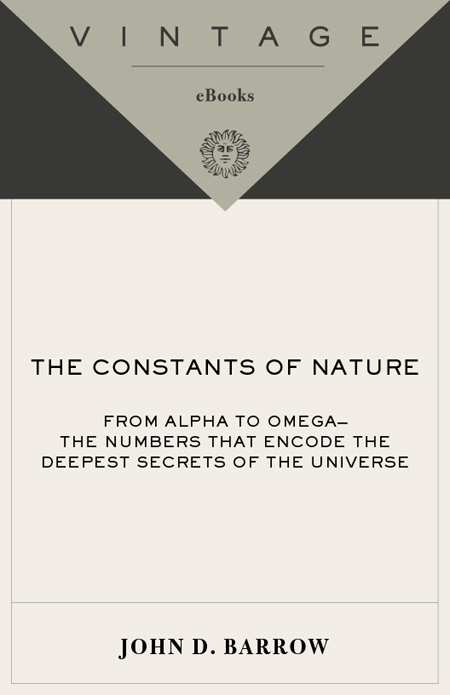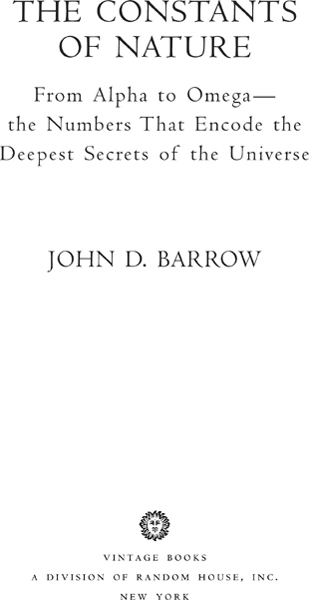The Constants of Nature

Acclaim for John D. Barrow and
THE CONSTANTS OF NATURE
“Barrow's efforts to relate scientific developments to wider cultural themes must be applauded.”
—Los Angeles Times Book Review
“Even when the science gets really difficult, Barrow explains it with great clarity, a lovely lightness of touch and enormous erudition.”
—The Spectator
“Barrow is possessed of a polymathic mind that swoops and soars…. [He] pours this vintage wine out of a Klein bottle of imagination and whimsy, which makes the reader's effort worthwhile.”
—The Washington Post
“Barrow… writes with liveliness and in a clear-headed, imaginative way…. He is…a master of his art.”
—The Decatur Daily
“Fascinating… with profound meanings as well as delightful humor.”
—Science Books & Films
“A scholarly though always accessible account…. For even the most complex of ideas, the author takes a breath to explain such matters as the Planck barrier and the laws of thermodynamics…. A satisfying excursion.”
—Kirkus Reviews
“Lively…. Raises important philosophical and even religious questions… [in] erudite but lucid prose. His account makes some of the most challenging frontiers of science accessible, even enthralling, to laypeople.”
—Publishers Weekly
“[Barrow] is a front-rank researcher whose recent investigation of quasars implies that one physical value (the fine structure constant) has strengthened since the formation of the early universe. A crystalline exploration of the constants, extra dimensions, and the fate of the universe…an exemplary popular presentation of high-level science.”
—Booklist
“[Barrow] explains how our assumptions about the constancy of the universe's physical parameters turn out to be wrong, [and he] takes us on a tour of what might be possible, given different assumptions about how everything works…. It's mysteries like these that make the book such a good read.”
—Focus (UK)
John D . Barrow
THE CONSTANTS OF NATURE
John D. Barrow is professor of mathematical sciences at the University of Cambridge. His previous books include The Book of Nothing, Theories of Everything, The Artful Universe, Between Inner Space and Outer Space, The Universe That Discovered Itself, and The Origin of the Universe. He lives in England.
ALSO BY JOHN D. BARROW
Theories of Everything
The Left Hand of Creation
(with Joseph Silk)
L'Homme et le Cosmos
(with Frank J. Tipler)
The Anthropic Cosmological Principle
(with Frank J. Tipler)
The World Within the World
The Artful Universe
Pi in the Sky
Perché il mondo è matematico?
Impossibility
The Origin of the Universe
Between Inner Space and Outer Space
The Universe That Discovered Itself
The Book of Nothing

To Carol
‘Not the power to remember, but its very
opposite, the power to forget is a necessary
condition for our existence.’
Sholem Ash
Contents
Preface
1 Before the Beginning
Sameliness
2 Journey Towards Ultimate Reality
Mission to Mars
Measure for measure – parochial standards
Maintaining universal standards
A brilliant idea!
Max Planck's natural units
Planck gets real
About time
3 Superhuman Standards
Einstein on constants
The deeper significance of Stoney-Planck units: the new Mappa Mundi
Otherworldliness
The super-Copernican Principle
4 Further, Deeper, Fewer: The Quest for a Theory of Everything
Numbers you can count on
Cosmic Cubism
New constants involve new labour
Numerology
5 Eddington's Unfinished Symphony
Counting to 15,747,724,136,275,002,577,605,653,961,181,555,468,044,717,914,527,116,709,366,231,425,076,185,631,031,296
Fundamentalism
Theatrical physics
6 The Mystery of the Very Large Numbers
Spooky numbers
A bold hypothesis
Of things to come at large
Big and old, dark and cold
The biggest number of all
7 Biology and the Stars
Is the universe old?
The chance of a lifetime
Other types of life
Prepare to meet thy doom
From coincidence to consequence
Life in an Edwardian universe
8 The Anthropic Principle
Anthropic arguments
A delicate balance
Brandon Carter's principles
A close-run thing?
Some other anthropic principles
9 Altering Constants and Rewriting History
Rigid worlds versus flexi worlds
Inflationary universes
Virtual history – a little digression
10 New Dimensions
Living in a hundred dimensions
Walking with planisaurs
Polygons and polygamy
Why is life so easy for physicists?
The sad case of Paul Ehrenfest
The special case of Gerald Whitrow
The strange case of Theodor Kaluza and Oskar Klein
Varying constants on the brane
11 Variations on a Constant Theme
A prehistoric nuclear reactor
Alexander Shlyakhter's insight
The Clock of Ages
Underground speculations
12 Reach for the Sky
Plenty of time
Inconstancy among the constants?
What do we make of that?
Our place in history
13 Other Worlds and Big Questions
Multiverses
The Great Universal Catalogue
Worlds without end
Journey's end
Notes
Preface
Some things never change. And this is a book about those things. Long ago, the happenings that made it into histories were the irregularities of experience: the unexpected, the catastrophic, and the ominous. Gradually, scientists came to appreciate the mystery of the regularity and predictability of the world. Despite the concatenation of chaotically unpredictable movements of atoms and molecules, our experience is of a world that possesses a deep-laid consistency and continuity. Our search for the source of that consistency looked first to the ‘laws' of Nature that govern how things change. But gradually we have identified a collection of mysterious numbers which lie at the root of the consistency of experience. These are the constants of Nature. They give the Universe its distinctive character and distinguish it from others we might imagine. They capture at once our greatest knowledge and our greatest ignorance about the Universe. For, while we measure them to ever greater precision, fashion our fundamental standards of mass and time around their invariance, we cannot explain their values. We have never explained the numerical value of any of the constants of Nature. We have discovered new ones, linked old ones, and understood their crucial role in making things the way they are, but the reason for their values remain a deeply hidden secret. To search it out we will need to unpick the most fundamental theory of the laws of Nature, to discover if the constants that define them are fixed and framed by some overarching logical consistency or whether chance still has a role to play.
Our first glimpses reveal a very peculiar situation.
1 comment